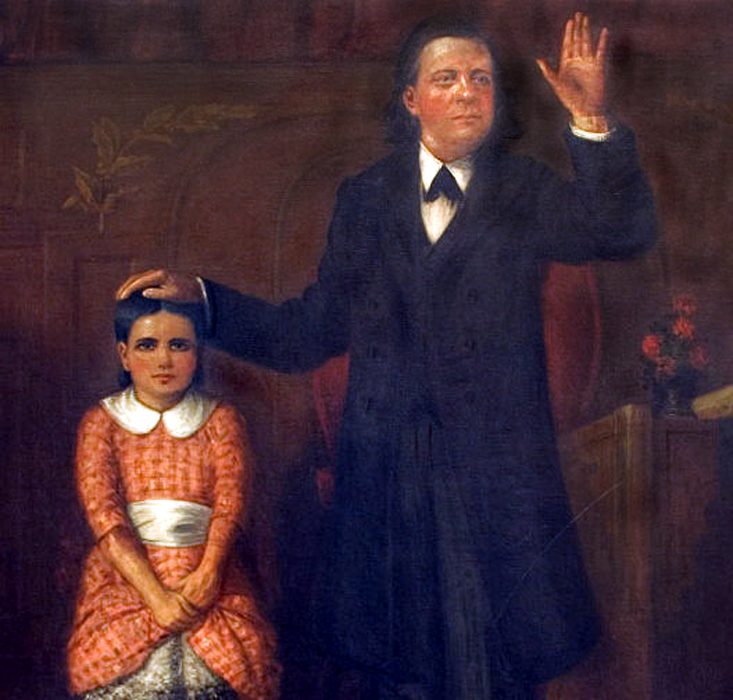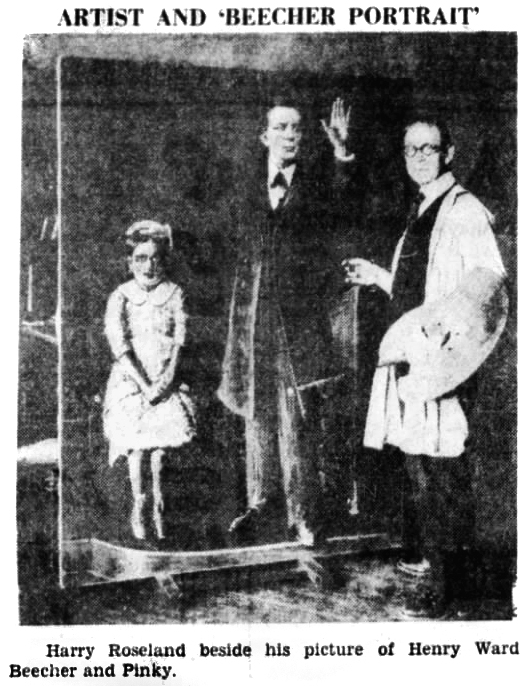
The Brooklyn Eagle
May 22, 1932
Plymouth Church Gets Slave Auction Picture
Pinky Returns on Canvas 72 After Henry Ward Beecher Won Her Freedom by Selling Her on Block

Pinky is coming back to Plymouth Church —this time to stay, Seventy-two years after Henry Ward Beecher, the famous orator auctioned her from "the slavery block" in the pulpit of historic old church on Orange St. where Lincoln twice worshipped, the nine-year-old mulatto slave girl returns on the oil-painted canvas of Harry Roseland, Brooklyn artist.
In. 1927 Pinky returned to Plymouth Church as the dignified, white-haired Mrs. Rose Ward Hunt. It was the only visit she made after that morning of Feb. 6. 1860, when Beecher obtained her freedom by the $2,000 tossed into the basket by the congregation.
Paints Sweet-Faced Child
But for her second return and final Homecoming. Mr. Roseland has painted a sweet-faced, frightened child, with hair parted demurely in the middle, a far cry from the Topsy of Harriet Beecher Stowe's book, by her side he has put her benefactor, Beecher.
The scene is a re-creation of the auction. It is as historically faithful us possible, Mr. Roseland contends. The important features and details he verified through research and personal investigation with persons who were eye-witnesses to the event.
The Picture is five feet four inches by six feet. The figures are life-size. It stands in Mr. Roseland’s studio at 246 Fulton St.
On Church Platform
It depicts Pinky at that sensational moment standing on the platform. Her dark eyes are Wide wonderment and her fingers twist the skirt of her red circular striped dress so that a bit of white petticoat shows.
Her feet, in black shoes, are slightly turned in "just as of a nervous child would be," thinks Mr. Roseland.
On her head is Beecher's right hand. This gesture is typical of the slave auctioneer, according to a letter in Mr. Roseland’s possession from Armand Hawkins. who once sold slaves in New Orleans.
Beecher's left band is raised, a personal characteristic of his in the pulpit. His mouth seems ready to open and ask "What am I bid?" He is wearing the conventional garb of the period with a black truck coat that flares at the bottom. His large black tie tucked under his collar.
Painted From Old Picture
Mr. Roseland painted the oratorical firebrand’s head from an old picture. The late Frederick Boston, prominent Brooklyn artist, posed for the figure. which is short and fairly slight as Beecher was In the middle period of life.
Pinkys head is from a painting done by Eastmond Johnson, executed at the request of the late Bishop Falkner of Christ Church, who brought Pinky to Brooklyn. A little Brooklyn girl, whose name Mr. Roseland does not remember, posed for the figure.
The Rev. Mr. Falkner was alive when the painting was started in 1927 and Mr. Roseland considered him a general consultant.
Pinky died in Washington, where she made her home, in 1928.
The chair shown in the composition is now in the gallery of Plymouth Church, but the pulpit is the property of Amherst College.
Illustrative of the detailed work Mr. Roseland has put into this painting is the little glass of flowers which stands on the pulpit. It was Beecher’s invariable custom to fresh flowers, so arranged, on the stand every Sunday, Mr. Roseland explained.
Negroes Raise Fund
It was the white hands of the members of Plymouth Church that sent Pinky into the world free, eventually to attend college, teach and marry happily. Dark hands are sending her back.
A group or Brooklyn Negroes headed by George E. Wibecan, former exalted ruler or the Negro Elks, raised the funds for the purchase of the picture.
The date of presentation has not been decided, but when it arrives, it will find Plymouth Church waiting with a hearty welcome for Pinky. One of the brightest pages in its history.